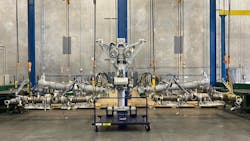How Maintenance Providers Can Help Ensure Safe Aircraft Landings
Wings and engines are crucial to flight, while landing gear, wheels and brakes ensure safe landings. Just as aircraft can’t fly safely without AMTs, they also can’t land safety without AMTs.
Ismaël Fadili, VP of sales – Europe for AMETEK MRO, said the overhaul process for wheels and brakes depends on what the customer is looking for. For example, is the repair for a wheel or a tire change?
“It's a quite simple process just getting the wheel in the shop, cleaning the wheel, replacing the tire, checking if there is no leakage after inflation. And then the new tire is going out within three, four days depending on the contract and the type of wheel you have to repair,” said Fadili.
On the other hand, if a wheel needs an overhaul, that involves complete disassembly and complete cleaning of wheels, bolts, keys and heat shields. Fadili said the wheel is stripped back to its raw material.
The wheel is then inspected via non-destructive testing (NDT) to see if there are any cracks or damage to the wheels and boards. NDT inspection includes magnetic particle inspection, eddy current testing, and ultrasonic inspection. The latter, Fadili notes, is new tech for AMETEK and they are in the process of training employees to use it.
“This is something quite new to use ultrasonic for wheels,” he said.
After NDT, the wheels are painted.
“We are applying first the primary paint and then the final paint, and then going back to the shop for reassembly and new tire. It's a quite simple, quite lean process,” he continued.
Fadili said that the overhaul process is largely the same for the brakes, outside of replacing tires. Instead, the overhaul involves replacing the lining on a steel brake, or the carbon impact for carbon brakes.
The overhaul cycle between tires, wheels and brakes varies greatly. Fadili said they’re often not worked on all at the same time. The type of aircraft plays a role. Large commercial jets will have a different overhaul cycle than smaller counterparts.
In general, Fadili said wheels and tires are overhauled every 200 to 400 cycles, with brakes between 1,200 to 200,000 cycles.
Wheels mostly wind up in need of repair due to worn tires and brakes need repair because of leakage, both are caused by normal wear and tear.
One factor that decreases the overhaul cycles is weather. In warmer climates and during the summer months, the wear on tires accelerates.
“Mostly during the summer season, we have much more removals than during the winter season because the temperature of the runway is much higher and it really degrades,” he said.
Fadili said AMETEK prepares and stocks up for the summer season because they know for sure that during the European hot season of June, July, August and September, tire removals increase 10 to 15% more than in the winter.
“We try to anticipate as much as we can. Of course, we try to have as much as we can in stock for the summer season. What we try to do is not to have an average consumption or to work on an average consumption all year, but really to increase our needs for the summer season,” he said.
AMETEK doesn’t see corrosion as a major cause of concern, he said but for aircraft operating in saltier regions, it can become a problem.
Landing Gear
While corrosion may not be of great concern for wheels and brakes, Raul Cruz-Alvarez, CEO and accountable manager, Landing Gear Technologies, said it’s enemy number one for landing gear.
“When I first started, it used to take one to two days to remove a nut because of the amount of corrosion that was on there,” he recounts.
Corrosion is such an issue due to a combination of water and the drastic, rapid temperature changes the landing gears experience. For example, using Landing Gear Technologies' home base of Miami, Florida, a plane can go from rainy, humid and 90 degrees Fahrenheit to 35,000 feet and minus 50 degrees in half an hour. And this process of extreme changes will likely repeat multiple times a day.
that starts day one after a landing gear is installed, Cruz-Alvarez notes.
“The first day you introduced the gear back on the aircraft and you start rolling it around, the corrosion's going to start setting in because of the differential temperature. And, just the humidity in the air. We always got to remember that air is a fluid anywhere we look at it. For however small, there are molecules of water in the air,” he said.
Nowadays, it no longer takes a couple days to remove a nut because of corrosion, thanks to their design and corrosion inhibitors, but the process to overhaul landing gear is remains work-intensive.
Broadly, landing gear will be overhauled every eight to 12 years, depending on the aircraft, with 10 years being the average. The number of cycles landing gear can see in that timeframe varies greatly between their use. Cruz-Alvarez has VIP customers whose planes only saw a few thousand cycles in those years. While on the other end, they service commercial freighters at well over 10,000 cycles.
“We do work for Federal Express and for UPS and those gears between overhauls, you're looking at around anywhere from seven to 10,000 cycles on that type of gear because they're freighters,” he said. “We just did the landing gears for the same aircraft, the 757 for President Trump on his personal aircraft, and that aircraft did around 1,800 cycles in 10 years.”
Regardless of how frequently an aircraft is flown, each overhaul runs the same course. It starts with a receiving inspection to take account of any damage or lost parts.
The landing gear is then torn apart back down to its base metals and components. Those parts are then put through a stress relief process.
“The landing gear goes in a stress relief oven for anywhere from four to 23 hours depending on the parts, to relieve the stress that it's had for the last eight to 12 years,” said Cruz-Alvarez.
NDT is the next step, and the most frequent step. Landing gear will undergo NDT multiple times throughout the overhaul process.
“Everything gets inspected through the non-destructive testing process, checking for cracks, burns, any kind of abnormalities on the base metal, whether it's aluminum, titanium or steel. They all go through the same process,” Cruz-Alvarez explained.
Magnetic particle and fluorescent penetrate, which is only used on non-steel parts, are the main types of testing used, in addition to ultrasonic and eddy current.
After NDT, gear goes to either to the electro plating department to strip the chrome, nickel or any other finishes it has, and parts get sent to the machine shop.
“In the machine shop, basically all the defects are taken out, all the corrosion, all the nicks, all the dings,” he said.
From here, after another round of NDT, the landing gear is nearly finished. The gear is compressed again because the work has opened up pores in the metal.
“You want to compact them back again to make it nice and hardened in order to be able to take the abuse that it's going to have for the next 10 years,” Cruz-Alvarez continued.
The landing gear then gets plating and the bushings are installed.
“I like to say that before that point, all the parts are different. You could have the same parts on the same aircraft on the left-hand gear and on the right-hand gear, and they're both different as they go through the machine shop and to the plating process.
“Once you get back to the bushing area, these bushings are installed using a shrink fit method, and that's where everything goes back to a standard dimension. So once you put in these bushings, it brings back everything back to the factory design dimension, so everything goes right back to where it was if was brand new on the exterior fitting parts,” he described.
Then it’s painting and paperwork and the landing gear is good to fly again.
How long the entire overhaul process takes varies depending on the type of aircraft. Cruz-Alvarez says you're looking at anywhere from the smallest gear taking 45 days to the largest gear taking around 90 days.


